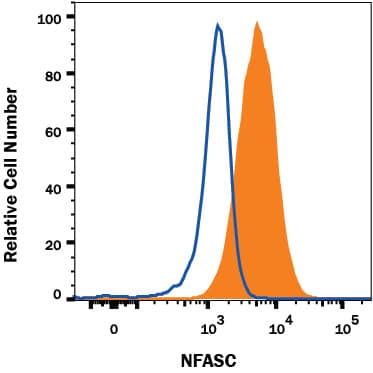Human Neurofascin Antibody
R&D Systems, part of Bio-Techne | Catalog # MAB8208


Conjugate
Catalog #
Key Product Details
Species Reactivity
Human
Applications
CyTOF-ready, Flow Cytometry
Label
Unconjugated
Antibody Source
Monoclonal Mouse IgG1 Clone # 1018843
Product Specifications
Immunogen
Human embryonic kidney cell, HEK293-derived human Neurofascin
Ile25-Trp1039
Accession # NP_055905
Ile25-Trp1039
Accession # NP_055905
Specificity
Detects human Neurofascin in direct ELISAs.
Clonality
Monoclonal
Host
Mouse
Isotype
IgG1
Scientific Data Images for Human Neurofascin Antibody
Detection of NFASC in U87-MG Human Cell Line by Flow Cytometry.
U87-MG human cell line was stained with Mouse Anti-Human NFASC Monoclonal Antibody (Catalog # MAB8208, filled histogram) or isotype control antibody (Catalog # MAB002, open histogram), followed by PE-conjugated Anti-Mouse IgG Secondary Antibody (Catalog # F0102B). View our protocol for Staining Membrane-associated Proteins.Applications for Human Neurofascin Antibody
Application
Recommended Usage
CyTOF-ready
Ready to be labeled using established conjugation methods. No BSA or other carrier proteins that could interfere with conjugation.
Flow Cytometry
0.25 µg/106 cells
Sample: U87-MG human cell line
Sample: U87-MG human cell line
Formulation, Preparation, and Storage
Purification
Protein A or G purified from cell culture supernatant
Reconstitution
Reconstitute at 0.5 mg/mL in sterile PBS. For liquid material, refer to CoA for concentration.
Formulation
Lyophilized from a 0.2 μm filtered solution in PBS with Trehalose. *Small pack size (SP) is supplied either lyophilized or as a 0.2 µm filtered solution in PBS.
Shipping
Lyophilized product is shipped at ambient temperature. Liquid small pack size (-SP) is shipped with polar packs. Upon receipt, store immediately at the temperature recommended below.
Stability & Storage
Use a manual defrost freezer and avoid repeated freeze-thaw cycles.
- 12 months from date of receipt, -20 to -70 °C as supplied.
- 1 month, 2 to 8 °C under sterile conditions after reconstitution.
- 6 months, -20 to -70 °C under sterile conditions after reconstitution.
Background: Neurofascin
References
- Rathjen, F.G. et al. (1987) Cell 51:841.
- Volkmer, H. et al. (1992) J. Cell Biol. 118:149.
- Sherman, D.L. and P.J. Brophy (2005) Nat. Rev. Neurosci. 6:683.
- Kriebel, M. et al. (2012) Int. J. Biochem. Cell Biol. 44:694.
- Liu, H. et al. (2011) J. Biol. Chem. 286:797.
- Collinson, J.M. et al. (1998) Glia 23:11.
- Basak, S. et al. (2007) Dev. Biol. 311:408.
- Charles, P. et al. (2002) Curr. Biol. 12:217.
- Schafer, D.P. et al. (2004) J. Neurosci. 24:3176.
- Maier, O. et al. (2005) Mol. Cell. Neurosci. 28:390.
- Sherman, D.L. et al. (2005) Neuron 48:737.
- Maier, O. et al. (2006) Exp. Cell Res. 312:500.
- Volkmer, H. et al. (1996) J. Cell Biol. 135:1059.
- Koticha, D. et al. (2005) Mol. Cell. Neurosci. 30:137.
- Howell, O.W. et al. (2006) Brain 129:3173.
Alternate Names
NFASC, NRCAML
Gene Symbol
NFASC
UniProt
Additional Neurofascin Products
Product Documents for Human Neurofascin Antibody
Product Specific Notices for Human Neurofascin Antibody
For research use only
